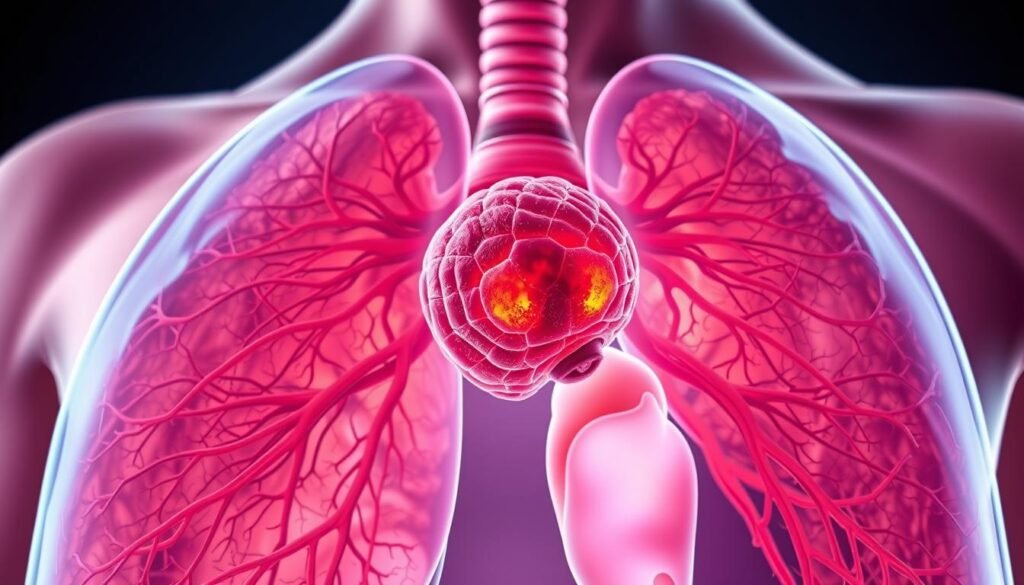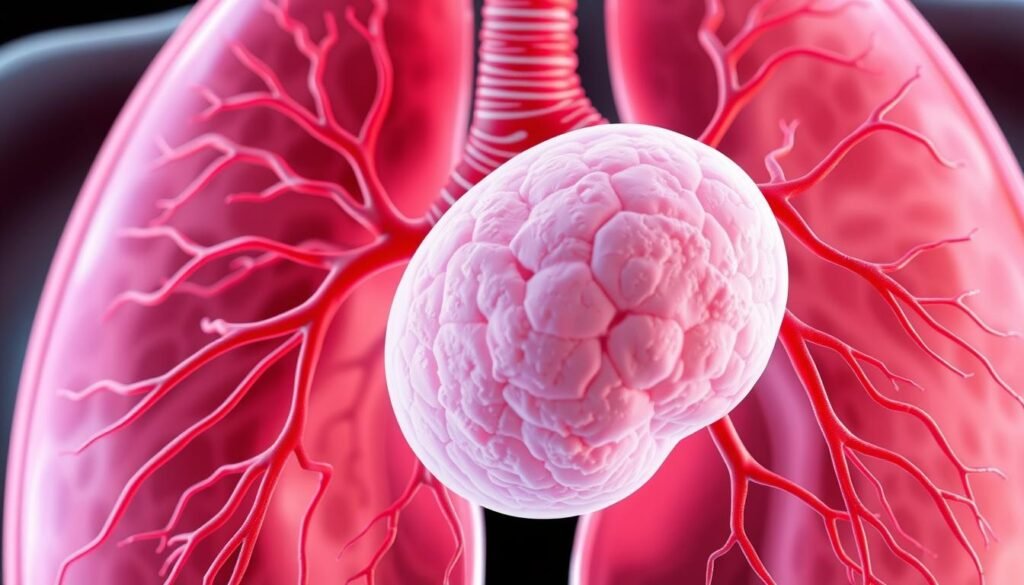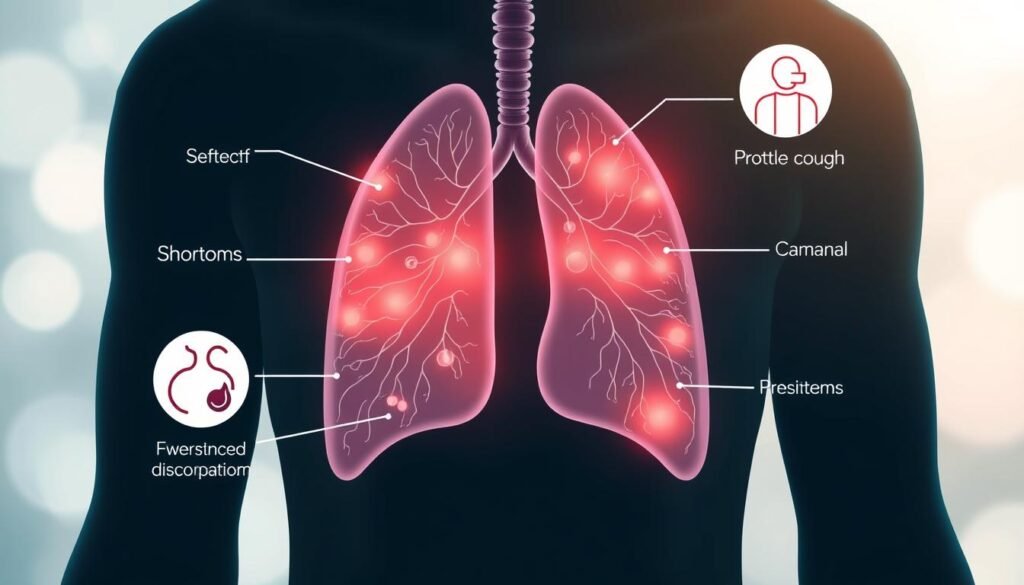Did you know only 1 percent of chest CT scans show a solitary pulmonary nodule or small mass, while 99 percent are benign? This fact can ease the worry of finding a lung mass. Though the term “lung mass” might scare you, many are benign lung tumors. They do not spread and aren’t deadly. Knowing about noncancerous lung growths and their symptoms can offer comfort to those dealing with this issue.
We will look into benign lung masses, like hamartomas, bronchial adenomas, and papillomas. We’ll explore what they are, how they behave, and how they’re treated. Our aim is to give patients knowledge about their condition. This encourages them to get medical help when needed. For more details on common benign lung tumors, read more here.
Key Takeaways
- Most lung masses found in imaging tests are noncancerous.
- Hamartomas are the most common benign lung tumor.
- Symptoms of benign lung tumors are rare and often discovered incidentally.
- Regular monitoring is essential for managing benign lung nodules.
- Understanding the types and characteristics of benign lung masses can reduce anxiety.
- Consultation with a healthcare provider is crucial for proper diagnosis and treatment.
Understanding Lung Masses
Lung masses are abnormal growths or areas in the lungs. They are bigger than 3 centimeters across. When found, these masses can make people worry about the possibility of cancer. Smaller growths are called pulmonary nodules and are usually less than 3 centimeters. Knowing the difference between these terms is key for diagnosing and treating them.
Definition of Lung Mass and Lung Nodule
A lung mass is bigger than 3 cm and might signal a serious condition. It could be either non-cancerous or cancerous. A pulmonary nodule is smaller and often discovered by accident during X-rays or CT scans. While many pulmonary nodules are not cancerous—about 60%—the situation of each lung lesion affects how doctors interpret them.
Key Differences Between Lung Mass and Lung Nodule
The main differences between a lung mass and a pulmonary nodule are their size, potential for cancer, and what they might mean for diagnosis. For example:
- Lung masses are larger than 3 cm, while nodules are smaller.
- Nodules smaller than 5 millimeters usually have less than a 1% chance of being cancerous. But those between 5 and 10 mm have up to a 28% chance of malignancy.
- Nodules bigger than 2 cm have a high chance of cancer, between 64% and 82%.
Finding lung masses early and understanding the risk factors are crucial. It helps in figuring out if a lung mass is not cancer. It’s very important to get a doctor’s help quickly, especially if there are symptoms like coughing, chest pain, or unexplained weight loss. You can find more about recognizing symptoms and treatment options here.
Common Types of Benign Lung Tumors
Benign lung tumors include many noncancerous growths, each different from the next. Knowing about these tumors helps doctors diagnose and manage them correctly.
Hamartomas: The Most Common Benign Lung Tumor
Hamartomas top the list as the most common benign lung tumor, making up about 55% of such tumors. These growths, usually seen as round masses on X-rays, tend to be smaller than 4 cm. Since patients may not show symptoms, regular imaging is key to spotting these lung issues.
Understanding Bronchial Adenomas
Bronchial adenomas are another familiar type of benign lung tumor. They start in the gland tissue inside the bronchi and can appear in organs like the colon and liver. Although they grow, they don’t spread, so finding them early is vital.
Papillomas and Their Types
Papillomas are the benign tumors found in the bronchial tubes. They come mainly in two kinds: squamous papillomas and glandular papillomas. Even though they’re not cancerous, they can cause breathing problems. So, watching them closely or removing them may be necessary.
Other Rare Benign Tumors
Aside from hamartomas and bronchial adenomas, there are less common benign tumors. These include chondromas, made of cartilage cells, and leiomyomas, from smooth muscle tissues. There are also lipomas, which grow slowly and are made of fat. These rare cases show how varied benign lung tumors can be.

For more details on benign lung tumors and what they involve, click here.
What is a Pulmonary Nodule?
A pulmonary nodule is like a small spot in the lungs, usually under 3 cm in size. These spots are often found by surprise in x-rays or scans. They can signal a lung mass not cancer, so it’s important to figure out what they are. Knowing about these nodules helps doctors tell if they’re simple benign lung tumors or something more serious.
Characteristics of Pulmonary Nodules
There are a few things doctors look at to understand a nodule. Important characteristics include:
- Size: Smaller nodules, under 1 cm, usually aren’t cancerous.
- Shape: Nodules that are smooth and round are often harmless, while spiky ones might be cancer.
- Calcification Patterns: Nodules with even calcifications are likely benign, uneven ones could be cancerous.
About 60% of these nodules turn out to be benign. It’s less common to find them in people under 35. So, age plays a big role in these cases.
Prevalence of Pulmonary Nodules in Imaging Tests
Doctors often spot pulmonary nodules in chest x-rays or CT scans, at a rate of about 1 in 500 x-rays. Around 40% of these nodules could be cancerous in patients tested. The chances of having nodules increases for people over 50, especially in those who smoke or used to smoke. Almost half might have nodules in their chest scans.
Tracking these nodules is key. Cancerous ones may grow fast, doubling in size in just four months. But, benign ones don’t usually need treatment and stay the same size.

Symptoms of a Lung Mass Not Cancer
Knowing about symptoms of a lung mass that isn’t cancer is key for early help. Even though benign lung masses don’t usually show symptoms, some people may notice signs. These signs could mean there’s a lung mass. It’s important to know these signs so you can get medical advice on time.
Common Symptoms Associated with Benign Lung Tumors
Symptoms with benign lung masses might not always show. But, if they do, these symptoms can include:
- Coughing
- Wheezing
- Breathing difficulties
- Recurrent lung infections
Benign tumors like hamartomas and bronchial adenomas usually stay quiet. Yet, any symptoms need early spotting. Spotting them early helps with the next steps and checks.
When to Seek Medical Attention
If someone has the symptoms listed and tests show a lung mass, seeing a doctor is critical. A lung mass not cancer still needs a close look. This is to find out if it’s truly benign or something more severe. Doctors might suggest more tests, like scans or a biopsy, to understand the mass better.

Diagnostic Procedures for Lung Masses
Finding lung masses means doing several tests to get it right and figure out treatment. First, doctors use imaging tests to see the mass. They look at its size and other key traits. This helps them understand what they’re dealing with.
Imaging Techniques: X-rays and CT Scans
X-rays and CT scans are the main tools for looking at lung masses. These imaging tests are good at spotting things that shouldn’t be there. X-rays give us a quick peek. But CT scans show us the nitty-gritty details, like the mass’s shape and how solid it is. Most of the time, things found on CT scans aren’t cancer. They could be scars or signs of old infections.
Biopsy and Its Importance in Diagnosis
If imaging shows something unusual, a biopsy might be needed. This test takes a small piece of the lung to look at more closely. It can be done in different ways, like with a special scope or a thin needle. This is guided by CT scans for accuracy.
After the biopsy, a specialist checks the sample for cancer, infection, or other lung issues. If they don’t find cancer, doctors might just keep an eye on it with more scans.
Comparison with Malignant Lung Masses
To tell benign from malignant lung masses, we look at size, shape, and how fast they grow. Knowing these details helps doctors figure out what they are dealing with. Malignant masses are usually bigger, oddly shaped, and grow quickly. On the other hand, benign masses are smaller, have clear edges, and grow slowly. Doctors use imaging to see these differences which helps in deciding the right treatment.
Differences in Size, Shape, and Growth Patterns
Examining the physical look of lung masses tells doctors if they are likely benign or malignant. Below is a table with some key differences:
| Characteristic | Malignant Lung Masses | Benign Lung Masses |
|---|---|---|
| Size | Generally larger than 3 cm | Usually smaller, often |
| Shape | Irregular | Well-defined |
| Growth Rate | Rapid | Slow or non-growing |
| Imaging Appearance | Imprecise margins, solid opacity | Ground-glass opacities |
Risk Factors for Lung Cancer
Many factors increase the chance of getting lung cancer. Smoking is the biggest risk, linked to many lung cancer cases. Other risks come from being around harmful materials like asbestos and radon, along with genetic backgrounds. As people get older, their risk also goes up. Early screening is key, especially for those at high risk. Reading up on lung cancer risks can help people understand and avoid them.
In short, knowing about lung mass types and cancer risks is crucial. It leads to the right medical steps being taken. Doctors need to spot the differences between lung masses for the best care.
Potential Causes of Benign Lung Masses
It’s vital to know what causes benign lung masses for proper diagnosis and care. Many things lead to these masses, like infections, inborn conditions, or non-cancerous tumors. It helps healthcare workers to design the right treatment when they know whether a lung mass comes from an infection or is something a person is born with.
Infection-Related Lung Masses
Infections can cause lung masses. These might follow lung abscesses or granulomas. They come from bacterial diseases such as tuberculosis and pneumonia. They can also come from fungal diseases, like histoplasmosis and aspergillosis. Our immune system fights these infections and might form safe structures. Knowing how this works helps in checking lung masses and can calm patients about their benign nodules.
Congenital Conditions and Other Noncancerous Causes
Born with conditions, bronchogenic cysts, for example, also lead to benign lung masses. These cysts are safe and come from lung tissue development issues. There are also benign tumors, like hamartomas. They are made of normal cells and appear as lung masses. Understanding these conditions are usually safe points out why it’s crucial to keep an eye on them and detect them early.
For more info on lung nodules and their causes, check out this informative guide.
Treatment Options for Benign Lung Masses
Treatment options for benign lung tumors often start with watching rather than surgery. Many benign masses don’t need treatment unless they grow, cause symptoms, or impact lung function. Doctors focus on tracking these masses closely.
Monitoring vs. Surgical Intervention
The treatment plan depends on the tumor’s features. Small nodules, especially those under 0.6 cm, usually go away on their own with little risk of becoming cancer. Doctors may then choose to check up on the patient regularly. This often includes CT scans every 2 to 5 years to watch for changes. If a nodule grows or shows worrying signs, surgery might be needed.
Importance of Regular Follow-ups
Regular check-ups are key in managing benign lung tumors. Patients might have imaging tests often to catch any changes quickly. For those at higher risk, like smokers or people with a history of lung cancer, these appointments are crucial. They help keep an eye on lung health.
| Treatment Approach | When to Consider | Follow-up Frequency |
|---|---|---|
| Monitoring | Nodules | Every 6-12 months for initial years |
| Surgical Intervention | Growth in size or symptomatic changes | As recommended post-surgery |
| Imaging Follow-ups | Patients with significant risk factors | Annually or biannually |
Conclusion
Understanding lung masses is key for easing worries about health risks. It’s crucial to know that not all lung masses are cancerous. They can come from harmless conditions. This knowledge lets people make smart health choices.
A lot of lung masses found in patients are actually benign. This means they’re not harmful. In fact, smaller ones rarely turn into cancer. For example, coughing was a symptom in 31.2% of a study group. This symptom encourages people to get checked out sooner.
Thanks to better diagnostic tools and treatments, dealing with benign lung masses is more successful now. Methods like lung biopsy and partial removal show great results with few problems. Making more people aware that many lung masses are not dangerous is comforting. Keeping up with regular doctor visits and acting quickly on any symptoms improves health. This way, people can manage their lung health well.